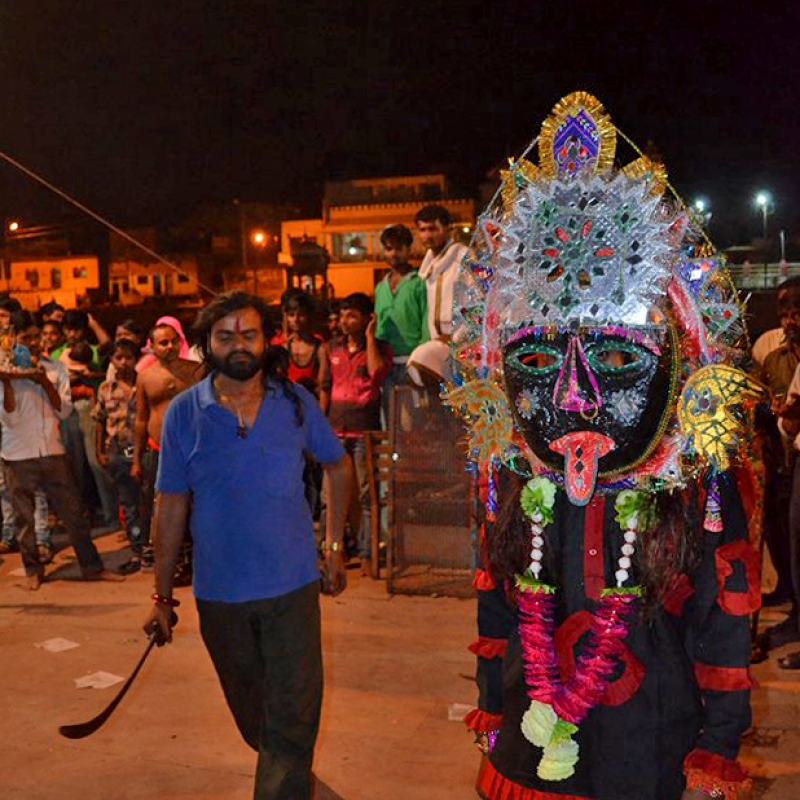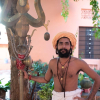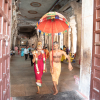এসেছিলাম মধ্যপ্রদেশের জব্বলপুরে... সেখান থেকে যাবার কথা ছিল পাঁচমারি। জব্বলপুর রেলওয়ে স্টেশনে টিকিট কাটতে এসে দেখি বিরাট একটা দল চলেছে চিত্রকূট... কি না নবরাত্রিতে তারা চিত্রকূটে কামতানাথ এর প্রদক্ষিণ করবে... ওখানেই নাকি রাম লক্ষণ আর সীতা বনবাসে এসে ছিল। রামায়ণের গল্পে আছে পিতৃসত্য রক্ষার্থে রাম তাঁর স্ত্রী সীতাদেবীকে নিয়ে চোদ্দ বছরের জন্য বনবাসী হন। সঙ্গী ছিলেন ভাই লক্ষণ। রাজধানী অযোধ্যা থেকে বের হয়ে তারা এসে ওঠেন ঋষি ভরদ্বাজ এর আশ্রমে। ভরদ্বাজ তাদের চিত্রকূট এ থাকার পরামর্শ দেন। তা রামচন্দ্র এখানে বেশ কিছুদিন ছিলেন। রাজা দশরথ মারা যাবার পর ভরত এখানেই এসে রামের সাথে দেখা করে তাকে অযোধ্যায় ফিরিয়ে নিয়ে যেতে আসেন। কিন্তু রামচন্দ্র জাননি। তখন ভরত রামের পায়ের খড়ম নিয়ে অযোধ্যায় ফেরেন কেয়ারটেকার রাজা হিসেবে।
জব্বলপুর স্টেশনের হিন্দু তীর্থযাত্রী দলের এক বুড়ো খুব হাত পা নেড়ে আমায় বোঝায় চিত্রকূট এর কামতানাথের রামসীতার মন্দির না দেখলে আর মন্দাকিনীতে একটা ডুবকি না লাগালে আর এই জীবনে কিই বা লাভ। তা ভাবলাম পাঁচমারির মত হিল স্টেশনে তো অনেকই গেছি, দেখি এই দলে দলে হিন্দু বিশ্বাসী কিসের টানে চলেছে। ব্যাস আর কি,সাতনা অবধি ট্রেনের টিকিট কেটে ফেললাম। সাতনা থেকে চিত্রকূট যাওয়ার গাদা গাদা বাস। অবশ্য পাবলিক বাসগুলি কলকাতার অটোর ও অধম... পারলে বাড়ি থেকে লোক ডেকে আনে!! পাহাড়ী রাস্তা আর জঙ্গলের মধ্যে দিয়ে সেই পাবলিক বাস আমাদের পৌছে দিল চিত্রকূট।
ছোট বড় বেশ কিছু হোটেল আর ধর্মশালা নিয়ে ছোট্ট গঞ্জ শহর। তবে তারকাখচিত ব্যবস্থা কিছু নেই। হোটেলগুলি বেশিরভাগই বাজেট হোটেল। চারিদিকে বিশাল বিশাল দূর্গের মত সব সাধুদের আখড়া। বাইরে থেকে দেখে বোঝার উপায় নেই ভিতরে কি হচ্ছে!! বিশুদ্ধ নিরামিষ খাবার দাবার। তন্দুর লাগানোই আছে সব লজ হোটেল ধর্মশালার সামনে... গরম গরম রুটি আর ভাজি। আগরবাল ভোজনালয়ের ছেলেটিকে ডিম পাওয়া যাবে কিনা বলতে সে আমাকে কানের কাছে ফিসফাস করে ভিতরে ডেকে নিয়ে গিয়ে বল্ল, খেতে চাইলে ব্যাবস্থা করে দিতে পারবে, একটা ছেলেকে সাইকেলে করে ৪ কিলোমিটার দূরে পাঠাতে হবে... আর লুকিয়ে ভেজে দেবে.... তবে খরচা করতে হবে.... নাহহ ডিম খেতে আর ইচ্ছে হয়নি।
তবে মন ভরে গেল রামঘাটে এসে... যেন কাশীতে এসে পড়লাম!! সেই সন্ধ্যা আরতি..নৌকাবিহার। চিত্রকূট এর সবচেয়ে গুরুত্বপূর্ণ এবং জমজমাট জায়গা হল এই রামঘাট। মন্দাকিনী নদীর ধারে প্রাসাদের মত সব আশ্রম বাড়ি আর চওড়া পাথরে বাঁধানো ঘাট। বিকেলে প্রমোদভ্রমণের জন্য সাজানো নৌকা বাঁধা থাকে। ওপারে ভরত মন্দির। কে যেন বলল ভূভারতে ভরত রাজার নামাঙ্কিত মন্দির এই একটিই। পাশাপাশি আরো সব মন্দির আর আশ্রম, জায়গাটি দেখে আপনার মনে বেনারস এর সাথে তুলনা আসবেই আসবে।
আমরা যেদিন গিয়েছিলাম সেদিনটা ছিল দুর্গাপূজার নবমি। স্থানীয় ভাষায় নবরাত্রি। এটি এখানকার স্থানীয় হিন্দু ধর্মাবলম্বীদের কাছে একটি বিশেষ দিন। মহালয়ার দিন বাড়ির কুলদেবতার সামনে একটি পাত্রে মাটির উপর গেহু ছড়ান হয়... নদিন ধরে তারা বাড়ে... নবরাত্রিতে তার ভাসান হয় মন্দাকিনীর জলে। পরিবারের মেয়েরা মাথায় করে ঘট নিয়ে আসে আর পুরুষরা সামনে নাচতে থাকে। আর সে কি নাচ!!! অনেকের আবার মানত থাকে তারা চেন কাঁটা দিয়ে শরীর কে আঘাত করতে করতে নাচতে থাকে। মুখোস পরেও অনেকে নাচছিল। আমার সামনে কয়েকজন লোহার শলাকায় জিভ ফুঁড়ে নাচতে লাগলো। স্থানীয় ভাষায় একে জাবারে বলে। একটা ছয় ফুটের লোহার বল্লম মুখের মধ্যে নিয়ে নাচ... এ অনেকটা ট্রান্স এর মত। প্রথমবার এই ধরনের ধর্মীয় আচরণ দেখলে ভয় লেগে যায়। মুখোশ পরে নাচের মধ্যে শুভ আর অশুভর লড়াই দেখানো হয়। স্বাভাবিক ভাবেই নাচের শেষে অশুভ পরাজিত হয় শুভর হাতে।
চিত্রকূট ও তার চারপাশের সবকিছুতেই রাম সীতার উল্লেখ। এখান থেকে যাত্রা শুরু করে ৩ কি.মি. র মধ্যে কামাদগিরি। নাতিউচ্চ পাহাড়ের মাথায় রাম সীতার মন্দির অবস্থিত। পুরানমতে এখানে সস্ত্রীক রাম বাস করতেন। তাই তীর্থযাত্রীরা এই মন্দির তথা পুরো পাহাড়টিকেই পবিত্র বলে মানেন ও পরিভ্রমণ করেন। অজস্র বাঁদর এই মন্দিরের চারপাশে আছে। তাই পরিভ্রমণকারীদের সদা সতর্ক থাকতে হয়। আরো খানিক দুরে স্ফটিকশিলা। যেখানে বিশাল উঁচু একখণ্ড পাথরের উপর তিলকশোভিত কথকঠাকুর বসে আছেন। চারপাশে হাতজোড় করা শ্রোতার দল। সিঁড়িবেয়ে পাথরে উঠে বসে দেখি পাথরের উপর কিছু জায়গা গেরুয়া সিঁদুরে মার্ক করা আছে। মনদিয়ে কথকতা শুনে বুঝলাম ওই মার্ককরা জায়গাগুলোতে রাম ও সীতার পায়েরছাপ আঁকা আছে বলে মনে করা হয়। রামচন্দ্র নাকি ওই স্ফটিকশিলার উপর বসে নিজেহাতে মালা গেঁথে সীতাকে সাজান। এই শিলার পাশেই বইছে মন্দাকিনী নদী। যথারীতি পুরো এলাকা বাঁদরে ভর্তি। রামায়ণ অনুসারে চিত্রকূটে বাবার শ্রাদ্ধকাজ কমপ্লিট করে রামচন্দ্র সবাইকে নিয়ে অত্রি মুনির আশ্রমে যান। এই সেই সপ্তর্ষির অত্রি মুনি, যার স্ত্রী মহাসতী অনসূয়া। মন্দাকিনী নদীর উৎপত্তি নিয়েও এই অনসূয়ার নাম জড়িয়ে আছে। মা গঙ্গা নাকি এনার সঞ্চিত পূন্য নিজের জলে মিশিয়ে পাপ ধুয়েফেলায় সক্ষম হন ও সেই পূন্যের পরিবর্তে এখানে মন্দাকিনী নদীর সৃষ্টি করেন। প্রসংগত বলে রাখি মন্দাকিনীর আরেক নাম পয়স্বিনী। রাম সীতা অত্রির আশ্রমে একরাত্রি কাটান ও তারপর অত্রির পরামর্শে দন্ডকারন্যের দিকে এগিয়ে যান। এখানে এখন সতী অনসূয়ার বিশাল মন্দির। মন্দিরে ঢোকার মুখে মাথার উপর রথ ও রথীর মুর্তি। এছাড়া মন্দিরের ভিতরে অনসূয়ার পুরো জীবনকথা যা পুরানে পুরানে ছড়িয়ে আছে তার মুর্তি বানানো আছে। আরেকটা কথা না বললেই নয়, সেটা হল মন্দাকিনীর নির্ভীক মাছেদের কথা। এই মন্দিরের পাশে নদীর ঘাটে যারা স্নান করছে তাদের গায়ের কাছে খাবার খোঁজে ঘুরে বেড়াচ্ছে ঝাঁকেঝাঁকে মাছেদের দল।
চিত্রকূটের কাছাকাছি সব থেকে ইন্টারেস্টিং যায়গা হল গুপ্ত গোদাবরী। অনেকগুলো সিঁড়ি চড়ে দুটো প্রাকৃতিক গুহা। একটা গুহা একটু সরু, কিন্তু ঢোকার রাস্তা বেশ চওড়া। স্যাঁতসেঁতে একটা ব্যাপার টের পাওয়া যায়। বেশ অনেকটা গিয়ে বাঁক নিয়ে এক জলের কুন্ডের কাছে গিয়ে শেষ হচ্ছে। এই কুন্ডের নাম লক্ষন কুন্ড। পরের গুহাটা অনেকটা লম্বা আর জলে ভরা!
I was at the Jabalpur railway station when I met the pilgrims—a large, vibrant group of men and women on their way to Chitrakoot, the site of Ram's exile. On Navaratri, they said, they would perform a parikrama of the Kamtanath Temple. I was trying to buy tickets to Pachmarhi, the next stop in our itinerary. But as one elderly pilgrim explained, waving his hands, what is life if one hasn't paid a visit to the Kamtanath Temple? If one hasn't taken a holy dip in the Mandakini at least once in their lifetime, has one truly lived?
The Ramayana lore narrates the story of Rama's 14-year exile, to uphold his father's word, in the forest in the company of his wife, Sita, and his faithful younger brother, Lakshman. As the story goes, Rama took shelter at the ashram of the sage Bharadwaj, shortly after leaving his father's capital, Ayodhya. On Sage Bharadwaj's advice, Rama and his companions found themselves in a place called Chitrakoot, where they stayed for a while before moving onwards. It is here that Bharat came to meet Rama after King Dasharath's death, asking him to come back to Ayodhya as a king. Rama, ever so virtuous, chose not to return, so Bharat went back with Ram's simple hermit slippers instead, and reigned over Ayodhya as a caretaker-king.
I decided to find out what draws hundreds of Hindu devotees to Chitrakoot every year. It is not as though I haven’t visited hill stations like Pachmarhi before. So I bought train tickets up to Satna from where we could take a bus to Chitrakoot. It bears mentioning that the public buses in the region are worse than Kolkata's infamous autos. They would call passengers from their homes if they could. Nonetheless, it is a public bus that we took and travelled across hills and forests to arrive at the holy Chitrakoot.
A cluster of few hotels of various sizes and a couple of dharamshalas shape the present day sub-urban Chitrakoot. It has no stars to offer, but budget residences for the humble pilgrims who flock to the place. What stood out at first sight is the massive akharas all over town, impenetrable as forts, populated by Hindu sadhus. It is impossible to say what might be going on inside them, certainly not if one is merely outside, looking in. The food in Chitrakoot is purely vegetarian. Every lodge, every hotel, every dharamshala has a tandoor right in front, ready to serve hot rotis and bhaji to hungry pilgrims and devotees. I did ask the serving boy at the Agarwal Bhojanalaya if eggs were on the menu. He took me indoors and whispered with great caution that he could arrange for it. It would only cost me a minor fortune, and involve a four-kilometer long bicycle trek and utmost secrecy. I admit I did not particularly crave eggs on my plate after that.
However, stepping into Ram ghat was like finding myself in a slice of Kashi, with its evening aratis and leisurely boat rides. Ram ghat is perhaps the most important and vibrant space in all of Chitrakoot. There are rows of palatial ashrams by the Mandakini and wide bathing ghats paved in stone. Boatmen line up every evening for visitors who might wish for a pleasure ride. Across the river stands the Bharat Temple. I was told it is the only temple dedicated to Bharat in all of India. There are even more temples and ashrams next to it. A place like this cannot but be compared to Banares.
We had arrived on Durga puja's ninth day, Navami. The locals call the nine-day long festival Navratri (as in other parts of India). Navami is an important day of worship for the Hindus in Chitrakoot. On the first day of Navratri, Hindu householders scatter wheat on an earthen pot laid out before their household gods. They remain thus for nine days, after which it set afloat in the waters of the Mandakini. Women carry earthen pots on their head while the men dance. And what a dance it is! There are many who have made wishes before the gods, and they dance while lashing their bodies with chains and spikes. Some dance wearing masks. Some dance while piercing their tongues with iron rods. The locals call this practice jabare. Dancing with a six-foot iron rod in their mouths, as though in a trance… It is not unheard of to be outright terrified when witnessing such a practice for the first time! The masked dances, meanwhile, portray an epic struggle between the forces of good (Shubh) and evil (Ashubh), with good emerging victorious at the end of the dance.
Everything in and around Chitrakoot refers to the story of Rama and Sita. The Kamdagiri is about three kilometers from Chitrakoot, on top of which is a temple dedicated to Rama and Sita. Puranic tales claim that this was the residence of Rama and Sita, once upon a time. Pilgrims consider it a holy hill and duly conduct a parikrama around it. There are hundreds of monkeys chattering about the temple and its vicinity, and pilgrims therefore have to be careful as they go about their parikrama. A little further away stands the sphatik shila, a reddish-brown crystal rock, next to which, on a huge rock, is seated a kathak-thakur. He is adorned by a tilak, and surrounded by a worshipful audience. As I climbed up the stairs, I found that parts of the rock marked in saffron sindur. The kathak's narration explained the markings—they are Rama and Sita's footsteps. It is here that Rama strung garlands for Sita with his own hands.
The Mandakini flows by the sphatik shila. As mentioned, the place is overrun by an army of monkeys. According to the Ramayana lore, it is here that Rama undertook the last rites of his father, and traveled to the sage Atri's ashram. One of the hallowed seven stars, called Saptarshi ('seven sages'), now bear Atri's name. Atri's wife was the mahasati Anasuya, whose name is intimately woven with the origins of the river Mandakini. Ganga, it is said, was able to wash off her sins on account of Anasuya's collected virtues. The Mandakini was born in return. The river is also known as Payaswini for this very reason. Ram and Sita spent a night at Atri's ashram and went further towards the Dandakaranya, following the sage's advice. There is a large temple dedicated to the virtuous Anasuya, with a statue of a chariot and its charioteer on top of the entrance to the temple. More statues narrating the Puranic tales of the life of the sati Anasuya adorn the temple. Another thing that I must mention is the fearless fish of the Mandakini! They flock near those who bathe in the river in search of food.
The most interesting spot near Chitrakoot is perhaps the Gupt Godavari caves. It is a natural cave that one can access after climbing a number of stairs. One cave is somewhat damp and narrow leading to a winding path that ends near a small water source, called the Laxman Kund. The other cave is larger and filled with water. I felt like quite the adventurer while exploring the caves.













